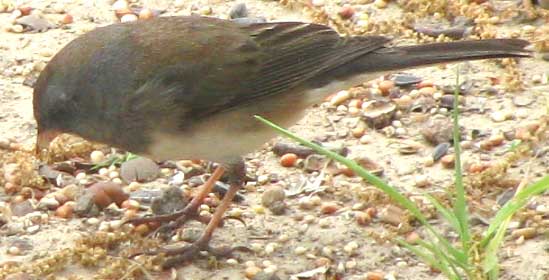Excerpts from Jim Conrad's
Naturalist Newsletter

from the the March 23, 2009 Newsletter, issued from the forest near Natchez, Mississippi; elevation ~400ft (120m), ~N31.47°, ~W91.29°:
SNOW-BIRD VARIATIONS
Above you see a Dark-eyed Junco, JUNCO HYEMALIS, with a plumage unlike any illustrated among the new Smithsonian field guide's eight photos, which mean to emphasize how variable the Dark-eyed Junco's plumage can be. The junco in the picture is one of several coming daily to peck in the gravel parking area outside Karen's window where occasionally she tosses birdseed just for them.
Among the little flock of maybe half a dozen birds not one individual looks exactly like any of the rest. In the old days field guides called them Slate-colored Juncos and certain plumage variations were recognized as distinct species, such as the "Oregon Junco," but nowadays they're mostly lumped into one "polymorphic" species. The Yellow-eyed Juncos we've seen in Mexico's highlands remain a distinct species, however. A "classic junco" and several variations are shown at http://sdakotabirds.com/species/dark_eyed_junco_info.htm.
As a child I was taught to call juncos Snow Birds, and it's true that usually I didn't notice them except during unusual Kentucky snows when they'd come in from fallow soybean fields and feed on the ground beneath our birdfeeders. As in Kentucky and here, in most of the US Dark-eyed Juncos are only winter visitors, permanent breeding populations being restricted to higher elevations, New England and the Pacific Coast. During the summer nesting season the population shifts northward to include Canada and Alaska.
from the September 4, 2005 Newsletter, issued from the Sierra Nevada Foothills east of Sacramento, California:
OREGON JUNCOS
At this time of year I seldom see juncos at this elevation. However, when I backpack to around 3500 feet they start showing up, even in mid summer. They're permanent residents in western North America's mountains, as well as the East's higher Appalachians and New England.
However, the high-elevation juncos I see here are very different from the ones back East. The ones here have dark gray heads and upper chests and white bellies just like the eastern birds but their backs and wings are pale brown. They look like brown birds who have had their heads dipped into dark gray paint.
When I was a kid these brown-backed juncos were regarded as a different species from the eastern birds. The books called the eastern juncos Slate-colored Juncos, and the brown-backed western species Oregon Juncos. There were other juncos, too, such as the White-winged, Gray-headed and Guadalupe Juncos. A map showing the summer distribution of "Oregon Juncos" at http://www.mbr-pwrc.usgs.gov/id/framlst/BBSMap/ra5679.gif.
Now all those different junco types, including our "Oregon Junco," are lumped into one big coast-to-coast taxon known as the Dark-eyed Junco. In areas where the various subspecies' distributions overlap there is just too much interbreeding and intergrading for the different populations to be maintained as distinct species.
By the way, you'd understand the Dark-eyed Junco's name if you saw the bright YELLOW eyes of the Mexican Junco so common in Mexico above about 5000 feet.